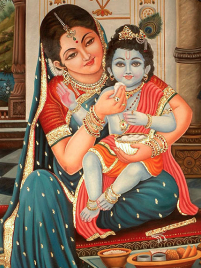A 421-Course Meal for Krishna
By S. T. Beuria | Jan 15, 2011

The skyrocketing prices of vegetables and articles did not deter an ashram from preparing over 400 varieties of dishes for Byanjan Dwadashi.
A nice and satisfying meal contains five or six, or at the most 10 to 12 varieties of dishes. But what happens when the number of dishes in the platter goes up to more than 400?
It may sound untrue but a religious place in the temple town of Puri in Orissa –Gourabihar Ashram — was recently in the news for entertaining devotees with a meal that had as many as 421 types of dishes.
The lavish platter included 16 varieties of ‘anna’ (rice), 15 types of dal, 95 varieties of curry, 53 varieties of fried vegetables, 18 types of ‘saag’ (curry made out of green leaves) besides 10 types of ‘chutney’. The interesting menu also included 12 types of ‘kheer’ and many other varieties of sweets.
The occasion on which the devotees were served with this sumptuous meal was Byanjan Dwadashi, an annual religious event.
Every winter, temples, mutts and ashrams in Orissa celebrate a number of unique and interesting religious festivals. And one among them is Byanjan Dwadashi. A significant feature of this colourful religious event is preparation of various kinds of food for god and goddesses, particularly Krishna and his incarnations like Jagannath of Puri.
The festival has been celebrated in Orissa for centuries. According to the legend, the beginning of the festival dates back to the era of Lord Krishna of the Hindu mythology. On this day – 12th day of the month of Margashira of the Hindu calendar – mother Yashoda used to cook varieties of mouth-watering dishes for naughty Krishna to appease him and keep him under control. Since then, the day is being celebrated as Byanjan Dwadashi.
The preparation for this grand religious food festival begins the previous night of Byanjan Dwadashi. With their own resources as well as with donations from the devotees, the managements of the temples, ashrams and mutts make elaborate arrangements for the cooking of different dishes. Sometimes, devotees too extend their helping hands in cooking.
Once the dishes are prepared by noon next day, they are first offered to the deities. Then they are served to the devotees and their family members as ‘prasad’. In ashrams like the one in Puri where the festival is celebrated in a grand manner, devotees gather in hundreds to have a look at the mouth watering dishes as well as to taste them.
In some places, devotees prepared different varieties of food in their homes and carry them to the temple to offer to the deities and subsequently serve the dishes among the people present in the shrine.
‘It is not about food alone. Because the festival signifies mother Yashoda’s love for Krishna, it is believed that sharing of the prasad makes relationships more strong. Therefore, we make it a point to participate in the festival every year”, says Pabitra Mohanty, a devotee.
Apart from the Puri ashram, some other shrines in the state where the festival was celebrated in a big way this year included the Krishna temple at Shashigopal near Puri as well as the Radha Krishna temple in Takarada in southern Ganjam district. However, the number of dishes in these temples was no where comparable to the figures at the Puri ashram. Some Krishna temples in capital Bhubaneswar had also celebrated the festival in a big way.
According to old timers, in the past, Byanjan Dwadashi was celebrated in a grand manner in almost all the Radha-Krishna temples in the state. “However, the scale of festival has now reduced to symbolic only in many of these temples,” says Somnath Panda, a resident of old town area of Bhubaneswar.
Panda, 80, attributed this to various reasons, including lack of interest among the devotees, particularly the young, as well as the rapidly increasing prices of essential commodities like vegetables. “The festival definitely is a costly affair as one has to prepare so many dishes”, he said.
Agrees Satyabadi Mishra, the priest of a small Krishna temple in Bhubaneswar. “The prices of commodities like vegetables, oil and dal have been skyrocketing. In this circumstance how one can ask the devotees to contribute for the festival”, he asked. The 35-year-old priest had a symbolic Byanjan Dwadashi in his temple this year.















